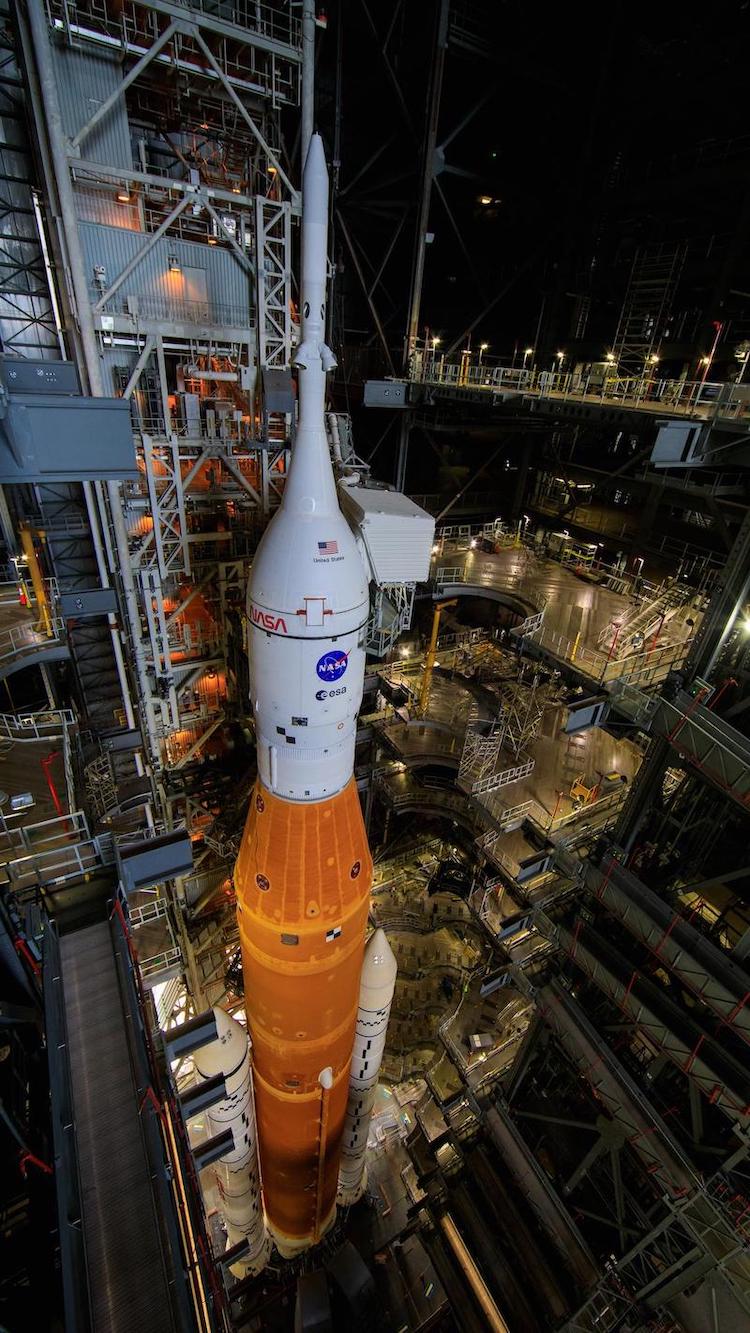NASA’s first Space Launch System moon rocket is set roll out to its launch pad early Monday at the Kennedy Space Center for another attempt later this month to fully load it with super-cold propellants, the culmination of a countdown rehearsal officials aim to complete before moving forward with launch later this summer.
The towering 322-foot-tall (98-meter) rocket is set to begin the journey at 12:01 a.m. EDT (0401 GMT) Monday with first motion out of High Bay 3 inside the Vehicle Assembly Building, the iconic hangar at Kennedy originally built to stack and service Saturn 5 moon rockets during the Apollo program.
The SLS moon rocket and its mobile launch platform will ride to pad 39B on a diesel-powered crawler-transporter. The 4.2-mile (6.8-kilometer) journey will take about 8 to 12 hours to complete, with arrival on top of the ramp at pad 39B expected after sunrise Monday. The full stack weighs about 21.4 million pounds for rollout.
The huge rocket is the largest ever built by NASA, and is the centerpiece of the agency’s Artemis moon program, which aims to return astronauts to the lunar surface later this decade. NASA is preparing the first SLS moon rocket for the Artemis 1 test flight, a demo mission to send an unpiloted Orion crew capsule around the moon and back to Earth on a shakedown cruise before it flies with people.
In the run-up to the Artemis 1 launch, NASA teams at Kennedy have stacked the SLS moon rocket and rolled the launcher to pad 39B for the first time March 18 in advance of a “wet dress rehearsal” to test out countdown procedures and fully load the rocket with more than 750,000 gallons of super-cold liquid hydrogen and liquid oxygen propellants.
But a series of technical snags prevented NASA’s launch team from completing the countdown rehearsal in April.
A problem with ground equipment at the launch pad delayed the test a day from April 3, then encountered issues with the supply of nitrogen gas to the launch pad. The nitrogen is used to purge compartments inside the SLS moon rocket.
A fueling attempt April 4 was cut short by concerns about the temperature of liquid oxygen flowing into the rocket’s core stage, then engineers discovered problem with a helium valve on the SLS upper stage.
The helium valve issue prevented the launch team from pumping propellants into the upper stage on the next fueling attempt. But NASA tried again April 14 to load cryogenic propellants into the core stage, but ran into more problems with the nitrogen supply. After temporarily overcoming the nitrogen issue, the launch team detected indications of a hydrogen leak near an umbilical connection at the bottom of the core stage.
NASA officials then decided to return the rocket to the VAB for repairs.

The Artemis 1 launcher rolled back to the hangar April 26, and technicians inside the high bay tightened seals on the umbilical connection in hopes of fixing the hydrogen leak. Workers also swapped out the balky helium valve on the upper stage, which failed due to rubber debris stuck in the mechanism. NASA said teams inside the VAB also worked to ensure no more debris would pose a problem for the new valve.
Meanwhile, upgrades at an off-site nitrogen gas plant near the Kennedy Space Center were completed to expand the system’s capacity for the SLS moon rocket. The nitrogen facility is operated by Air Liquide.
With the troubleshooting behind them, NASA teams decided to return to the Artemis 1 moon rocket to pad 39B for another countdown dress rehearsal, or WDR, later this month. If all goes according to plan, the next attempt to fully load the SLS moon rocket with propellant is scheduled for June 19.
Before then, ground teams at the space center will ready the rocket for the practice countdown. Those tasks will include loading the steering, or gimbaling, mechanism on the rocket’s two solid-fueled boosters with hydrazine fuel, which feeds hydraulic power units in the booster thrust vector control system.
The countdown test will end with a cutoff just inside T-minus 10 seconds, before ignition of the rocket’s four core stage engines.
If the launch team is able to accomplish the WDR, NASA will roll the Space Launch System back to the assembly building for final closeouts and testing. NASA will haul the rocket to pad 39B again for the real launch campaign, currently scheduled for no earlier than August.
Email the author.
Follow Stephen Clark on Twitter: @StephenClark1.
from Spaceflight Now https://ift.tt/vMJsLag
via World Space Info







0 comments:
Post a Comment